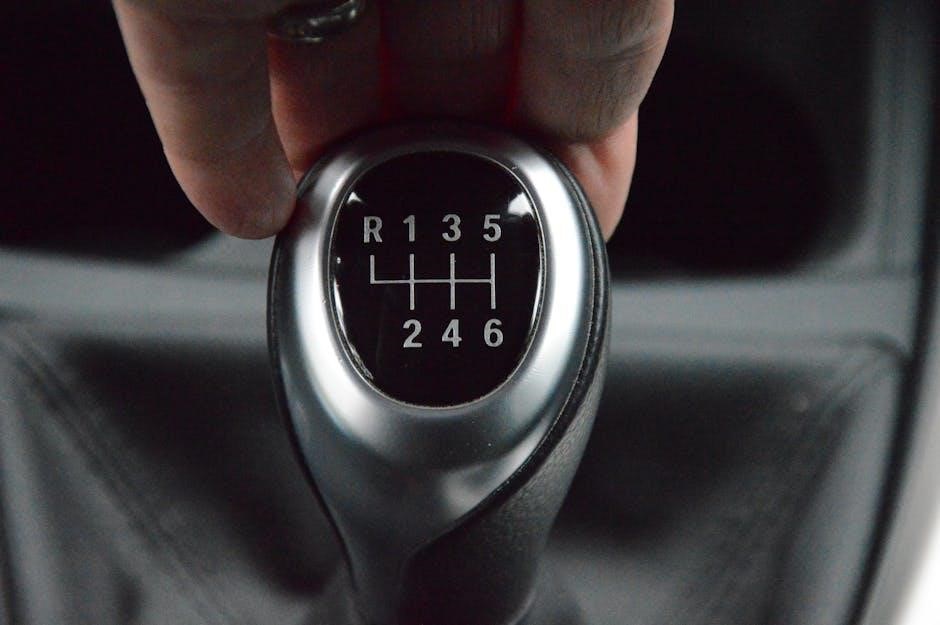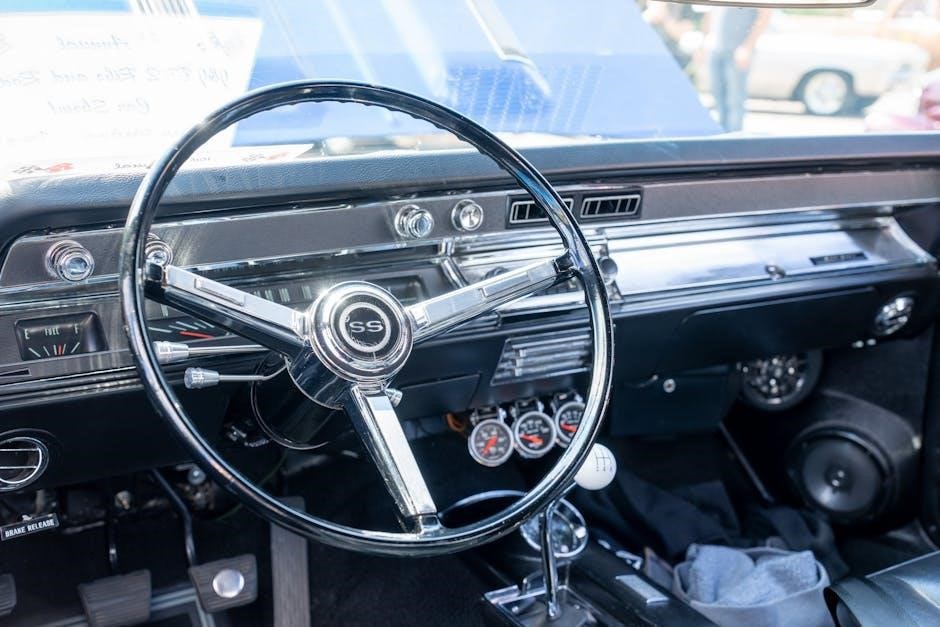
sbc manual transmission
Manual transmissions remain popular among performance enthusiasts for their control and cost-effectiveness. This guide explores SBC manual transmissions, covering key aspects for swaps, maintenance, and optimization.
1.1 What is an SBC Manual Transmission?
An SBC manual transmission refers to a gearbox designed for Small Block Chevy (SBC) engines, offering driver control over gear shifts. Unlike automatics, manual transmissions rely on a clutch pedal and shifter for operation. They are favored for their simplicity, cost-effectiveness, and performance potential. This guide explores SBC manual transmissions, including popular options, installation tips, and maintenance advice, tailored for enthusiasts seeking enhanced control and reliability in their builds.
1.2 Importance of Manual Transmissions for Performance Enthusiasts
Manual transmissions are highly valued by performance enthusiasts for their direct driver engagement and control. They offer precise gear shifts, better fuel efficiency, and a closer connection to the vehicle. Unlike automatics, manuals provide a more immersive driving experience, making them ideal for racing and high-performance applications. Their simplicity also reduces long-term maintenance costs, appealing to those seeking reliability and cost-effectiveness without sacrificing power or responsiveness.

Popular Manual Transmission Options for SBC Engines
The T-5 and T-56 are popular manual transmission choices for SBC engines, offering durability and performance. The T-5 is budget-friendly, while the T-56 handles higher horsepower.
2.1 T-5 Transmission Overview
The T-5 is a popular manual transmission for SBC engines, known for its durability and simplicity. It features a five-speed design with a robust gear set, making it suitable for lower horsepower applications. The T-5 is lightweight and compact, offering smooth shifting and excellent fuel efficiency. Its affordability and widespread availability make it a favorite among budget-conscious enthusiasts. With proper maintenance, the T-5 can deliver reliable performance, making it an ideal choice for SBC engine swaps in both classic and modern vehicles.
2.2 T-56 Transmission Specifications
The T-56 is a six-speed manual transmission designed for high-performance applications. It features a robust gear set, with a 2.66:1 first gear and a 0.50:1 sixth gear for optimal acceleration and cruising. The T-56 is known for its strength, handling up to 450 horsepower, making it ideal for modified SBC engines. Its compact design and overdrive capability enhance fuel efficiency and driver comfort. The T-56 is widely used in performance builds due to its reliability and versatility, offering precise control and smooth shifting for both street and track use.
2.3 Other Manual Transmission Options for SBC
Beyond the T-5 and T-56, enthusiasts can explore other manual transmissions for SBC engines. The TREMEC TKO 500/600 series offers excellent strength and close-ratio gearing, ideal for high-performance applications. The Richmond Gear 5-speed is another durable option, known for its simplicity and reliability. Additionally, the Borg-Warner T-10, while older, remains a budget-friendly choice for lower horsepower builds. Each option provides unique benefits, catering to different power levels and driving preferences, ensuring a wide range of choices for SBC swaps.
Components Needed for an SBC Manual Transmission Swap
Key components for an SBC manual transmission swap include a clutch kit, flywheel, bellhousing, adapter plate, crossmember, and shifter to ensure compatibility and smooth operation.
3.1 Clutch Kit and Flywheel Requirements

A suitable clutch kit and flywheel are essential for a smooth SBC manual transmission swap. The clutch kit must match the transmission’s spline count and engine’s horsepower. A flywheel designed for manual transmissions is required, often heavier for better low-end torque. Ensure compatibility with your engine and transmission type. Upgraded kits, such as organic or ceramic clutches, are recommended for high-performance applications. Proper alignment and installation are critical to avoid premature wear and ensure optimal performance.
3.2 Bellhousing and Adapter Plate Compatibility
Ensuring bellhousing and adapter plate compatibility is crucial for a successful SBC manual transmission swap. The bellhousing must align with the engine block and transmission, while the adapter plate bridges the engine and transmission. Compatibility varies by transmission type (e.g., T-5, T-56) and engine specifications. Always verify measurements and bolt patterns to avoid misalignment. Using the correct adapter plate ensures proper gear engagement and prevents damage. Consult a parts catalog or specialist for precise compatibility recommendations.
3.3 Crossmember and Mounting Hardware
The crossmember and mounting hardware are essential for securing the transmission to the vehicle’s frame. They must be compatible with both the SBC engine and the chosen manual transmission. Proper alignment and fitment are critical to prevent damage and ensure smooth operation. Adjustable or custom crossmembers may be necessary for specific setups. Always use heavy-duty hardware to handle the stress of high-performance applications. Consult a parts catalog or specialist to select the correct components for your swap.
3.4 Shifter and Linkage Setup
The shifter and linkage setup is crucial for precise gear engagement. A short-throw shifter can enhance shifting speed and driver experience. Ensure the linkage is properly aligned and adjusted to avoid misalignment. Compatibility with the SBC engine and transmission is key. Adjustable linkages or custom setups may be required for optimal performance. Always verify fitment and function before final installation. Proper setup ensures smooth, accurate gear changes and prevents potential damage to the transmission or drivetrain components.
Installation Steps for an SBC Manual Transmission
Installing an SBC manual transmission requires careful planning, compatibility checks, and precise execution. Follow step-by-step guides to ensure proper fitment and function, and perform thorough post-installation testing.
4.1 Pre-Installation Checks and Preparations
Before installing an SBC manual transmission, ensure compatibility with your engine and chassis. Inspect the clutch system, bellhousing, and adapter plate for proper alignment. Verify the crossmember and mounting hardware fit correctly. Check the shifter linkage and pedals for clearance. Gather all necessary tools and consult a step-by-step guide. Prepare the workspace and ensure the vehicle is securely lifted. Proper preparation prevents installation issues and ensures a smooth process.
4.2 Step-by-Step Installation Process

Begin by bolting the bellhousing and adapter plate to the engine. Align the manual transmission with the bellhousing, ensuring proper fitment. Secure the transmission using the provided hardware. Install the crossmember and mounting hardware to support the transmission. Connect the shifter linkage and clutch pedal assembly, ensuring proper alignment. Finally, attach the driveshaft and bleed the clutch system to remove any air bubbles. Double-check all connections for tightness and proper function before starting the engine.
4.3 Post-Installation Testing and Adjustments
After installation, start the engine and check for leaks. Test the clutch pedal to ensure proper engagement and disengagement. Shift through all gears to verify smooth operation. Adjust the clutch pedal free play and gear linkage for optimal performance. Take the vehicle for a short test drive to ensure proper shifting and acceleration. Inspect all connections and bolts for tightness. Monitor transmission fluid levels and top off if necessary. Address any unusual noises or vibrations promptly to prevent further issues.

Maintenance Tips for SBC Manual Transmissions
Regular fluid checks and changes are essential for smooth operation. Inspect the clutch pedal and adjust as needed. Lubricate gearbox components and monitor for wear or leaks.
5.1 Regular Fluid Checks and Changes
Regular fluid checks are crucial for maintaining optimal performance. Check transmission fluid levels monthly and change it every 30,000 to 60,000 miles. Use the correct type of fluid specified for your SBC manual transmission. Old or degraded fluid can cause slipping, hesitation, and gear wear. Always consult your transmission’s manual for specific recommendations. Proper fluid maintenance ensures smooth shifting and extends the lifespan of your gearbox. Neglecting fluid changes can lead to costly repairs down the road.
5.2 Clutch Pedal Adjustment and Inspection
Regular clutch pedal adjustment ensures smooth shifting and prevents premature wear. Check the pedal height and free play according to the manufacturer’s specifications. Inspect the clutch pedal bushings and linkage for wear or damage. Lubricate moving parts to maintain smooth operation. If the clutch engages unevenly or feels spongy, adjust or replace components as needed. Proper adjustment prevents clutch slippage and enhances overall performance. Regular inspections help identify issues before they escalate, ensuring reliable operation of your SBC manual transmission.
5.3 Gearbox Lubrication and Inspection
Regular gearbox lubrication is essential for smooth operation and longevity. Use high-performance gear oil suitable for your SBC manual transmission. Inspect gears, bearings, and seals for wear or damage. Check for leaks around the gasket and shaft seals. Replace the lubricant every 30,000 to 60,000 miles, depending on usage. Proper inspection helps identify potential issues early, preventing costly repairs. Keep the gearbox clean and well-lubricated to ensure optimal performance and durability.

Cost Considerations for an SBC Manual Transmission Swap
The cost of an SBC manual transmission swap varies, with components like the gearbox, clutch, and adapter plate influencing the total. Budget-friendly options exist.
6.1 Budget-Friendly Options and Components
For a cost-effective SBC manual transmission swap, consider the T-5 or T-56, which are affordable and widely supported. Used or refurbished components can significantly reduce costs. Ensure compatibility with your engine’s horsepower to avoid unnecessary upgrades. Shopping for second-hand parts or bundles from reputable sellers can also help stay within budget while maintaining performance and reliability.
6.2 Cost Comparison with Automatic Transmissions
Manual transmissions are generally more cost-effective than automatics, with lower purchase and maintenance costs. While automatics may offer convenience, manuals often require less complex repairs and have fewer components to replace. Over time, the simplicity of manual transmissions translates to long-term savings. For SBC engines, opting for a manual transmission can be more budget-friendly, especially for performance enthusiasts seeking both control and efficiency.

Troubleshooting Common Issues with SBC Manual Transmissions
Common issues include clutch slippage, gearbox noise, and shifting difficulties. Regular inspections and maintenance can help identify and address these problems early, ensuring optimal performance.
7.1 Diagnosing Clutch Slippage and Wear
Clutch slippage and wear are common issues in SBC manual transmissions. Symptoms include the clutch slipping when accelerating, especially under load. Inspect the clutch pedal for proper engagement and check the clutch disc and pressure plate for wear. Excessive wear or damage to the flywheel or pilot bearing can also cause slippage. Regular inspection and replacement of worn components are crucial to maintain optimal performance and prevent further damage to the transmission system.
7.2 Identifying and Repairing Gearbox Noise
Gearbox noise in SBC manual transmissions can stem from worn bearings, faulty gears, or insufficient lubrication. Common symptoms include grinding or whining sounds during shifting. Inspect the gearbox for damaged or worn components, such as the input shaft, output shaft, or gear sets. Replace any defective parts and ensure proper lubrication. Regular maintenance, including fluid checks and inspections, can help prevent noise issues and extend the transmission’s lifespan.
7.3 Solving Shifting Difficulties and Hesitation
Shifting difficulties and hesitation in SBC manual transmissions often arise from issues like worn clutch components, low transmission fluid levels, or misaligned linkage. Start by inspecting the clutch pedal adjustment and ensuring proper fluid levels. Check the shifter linkage for looseness or damage. If problems persist, consider replacing worn synchros or bearings. Regular maintenance, such as lubrication and adjustments, can prevent these issues and ensure smooth, precise shifting performance.

Performance Enhancements for SBC Manual Transmissions
Upgrade your SBC manual transmission with a high-performance clutch, short-throw shifter, and optimized gear ratios for enhanced power handling, faster shifts, and improved drivetrain efficiency.
8.1 Upgrading the Clutch for Higher Horsepower
Upgrading the clutch is essential for handling higher horsepower in SBC manual transmissions. A high-performance clutch kit with ceramic or multi-plate design provides superior grip and durability. Pair it with a lightweight flywheel for quicker acceleration. Ensure the pilot bearing and alignment tool are compatible. This upgrade enhances torque capacity and prevents slippage under heavy load. Professional installation is recommended for optimal performance and longevity of the drivetrain components.
8.2 Installing a Short-Throw Shifter for Faster Shifts
Installing a short-throw shifter enhances shifting precision and speed, ideal for performance driving. It reduces the distance between gear shifts, allowing quicker acceleration and better control. Compatibility with SBC manual transmissions ensures seamless integration. Proper installation requires adjusting the shifter linkage and potentially modifying the shifter mount. This upgrade is cost-effective and delivers immediate improvements in drivability without major modifications, making it a popular choice for enthusiasts seeking enhanced performance.
8.3 Optimizing Gear Ratios for Specific Applications

Optimizing gear ratios for specific applications enhances performance by matching the transmission to the engine’s power output and vehicle weight. For SBC manual transmissions, selecting the right gear ratios improves acceleration and top speed. Consider factors like horsepower, torque, and intended use (e.g., racing, street driving). Close-ratio gears are ideal for track performance, while wider ratios suit highway driving. Consulting with transmission specialists ensures the best configuration for your setup, maximizing efficiency and drivability in any scenario.
Benefits of Manual Transmissions Over Automatics
Manual transmissions offer improved fuel efficiency, enhanced driver control, and lower maintenance costs compared to automatics, making them a preferred choice for performance enthusiasts and cost-conscious drivers alike.
9.1 Improved Fuel Efficiency
Manual transmissions typically offer better fuel economy than automatics due to greater control over gear shifts, optimizing engine RPM for optimal performance. This reduces unnecessary fuel consumption, especially in city driving. The simplicity of manual transmissions, with fewer components prone to energy loss, contributes to improved efficiency. For high-performance engines like the SBC, manual transmissions are often preferred for their ability to deliver power more effectively, enhancing both performance and fuel efficiency when driven correctly.
9.2 Enhanced Driver Control and Engagement
Manual transmissions provide drivers with greater control over their vehicle, allowing precise gear shifts that match driving conditions. This direct connection enhances engagement, making driving more enjoyable and immersive. For performance enthusiasts, the ability to manually manage torque and RPM delivers a more responsive and dynamic experience. The physical interaction with the clutch and shifter fosters a deeper bond between driver and car, especially in high-performance applications like the SBC engine.
9.3 Lower Maintenance and Repair Costs
Manual transmissions typically require less maintenance and have lower repair costs compared to automatics. With fewer complex components, manual transmissions are less prone to costly failures. While parts like clutches may need periodic replacement, they are generally more affordable than rebuilding an automatic transmission. Routine maintenance, such as fluid changes, is also simpler and more cost-effective, making manual transmissions a budget-friendly choice for long-term ownership and performance driving with SBC engines.
Conclusion
Manual transmissions for SBC engines remain a popular choice for performance enthusiasts, offering cost-effectiveness, driver control, and lower maintenance. Their reliability and simplicity make them a satisfying option for those seeking an engaging driving experience.
10.1 Final Thoughts on SBC Manual Transmissions
Manual transmissions for SBC engines offer a blend of performance, control, and cost-effectiveness. They provide a more engaging driving experience and are often more reliable than automatics. With proper maintenance, they can last for years, making them a great choice for enthusiasts. Whether for racing or daily driving, SBC manual transmissions continue to be a preferred option for those who value precision and power.
10.2 Encouragement for Enthusiasts to Explore Manual Swaps
Enthusiasts seeking enhanced control and performance should consider an SBC manual transmission swap. It offers a more immersive driving experience and can be cost-effective. With the right components and planning, a manual swap is achievable. Whether for racing or personal satisfaction, the rewards of a manual transmission far outweigh the challenges, making it a worthwhile project for any automotive enthusiast.